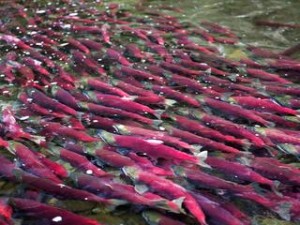06
Jun
EPA Agrees to Greater Protection of Salmon from Pesticides
(Beyond Pesticides, June 6, 2014) On June 4, after a two year dispute between the Environmental Protection Agency (EPA) and a coalition of conservation organizations and fishing groups, an agreement was finally reached to set reasonable no-spray buffer zones to protect salmon from five harmful insecticides: diazinon, chlorpyrifos, malathion, carbaryl, and methomyl.
 These buffer zones protect salmon habitat by stopping aerial spraying of pesticides within 300 feet, and ground based spraying within 60 feet of salmon supporting waters. According to the agreement, it also provides detailed notifications to state regulators, pesticide applicators, farmers and the public about the mandatory no-spray buffer zones. These stipulations will remain in place until the National Marine Fisheries Service has completed their analysis of the impacts of those five pesticides. Then, once the analysis is completed, EPA will execute permanent protections based on their findings.
These buffer zones protect salmon habitat by stopping aerial spraying of pesticides within 300 feet, and ground based spraying within 60 feet of salmon supporting waters. According to the agreement, it also provides detailed notifications to state regulators, pesticide applicators, farmers and the public about the mandatory no-spray buffer zones. These stipulations will remain in place until the National Marine Fisheries Service has completed their analysis of the impacts of those five pesticides. Then, once the analysis is completed, EPA will execute permanent protections based on their findings.
EPA is required by law under the Endangered Species Act to protect what little salmon are left on the Pacific Coast. Salmon are a critical indicator of how well we are maintaining both marine and terrestrial ecosystems, because their habitats are in streams, lakes, rivers, estuaries and the ocean. The fish are extremely sensitive to changes in water quality, and changes to the river flow. The more salmon there are the more diverse and productive a freshwater ecosystem can be. Salmon runs are also important because they provide a wealth of marine nutrients upstream to waters that are otherwise low in productivity. Declines in salmon can lead to drastic effects up the food chain because they are the main food source for numerous animals.
As said by Steve Mashuda, an Earthjustice attorney representing Northwest Center for Alternatives to Pesticides (NCAP), the conservation groups and fishing organizations, “This is a huge step forward for the health of our rivers and salmon fisheries. Before this agreement, we lacked effective ways to keep these poisons from entering our rivers and streams. EPA and the Fisheries Service can now continue to work together toward permanent protections that keep pesticides out of our waters.”
According to Jason Rylander with Defenders of Wildlife, “It’s kind of a no-brainer that salmon and pesticides don’t mix. Today’s agreement will go a long way towards ensuring that these highly toxic chemicals stay out rivers and streams and out of the food chain.”
Todd Steiner, executive director of Turtle Island Restoration Network stated, “Keeping these highly toxic pesticides out of streams and rivers protects the health of salmon and our children. It is way more cost effective than trying to clean up the mess after the fact.”
A 2004 court order required EPA to consult with the Fisheries Service over the impacts of these chemicals on salmon. That particular court order had expired when the Fisheries Service completed its analysis of the chemicals in 2008 and 2009. When the Fisheries Service required the EPA to implement a wider range of protections within a year, EPA failed to do so, leaving salmon and steelhead exposed and unprotected. This current agreement resolved years of litigation and will force the EPA to focus its time and energy on permanent solutions that will protect salmon.
The chemicals regulated under the new buffer zones are not only dangerous to salmon; they pose a significant threat human health, other wildlife, and the environment at large. Chlorpyrifos is acutely toxic to bees, birds, mammals, aquatic life, and certain species of algae. There are also a wide range of adverse environmental effects linked to chlorpyrifos, including toxic to: beneficial insects, freshwater fish, other aquatic organisms, and birds, variety of plants, soil organisms, and domestic animals. It has been shown to bioaccumulate in fish and synergistically reacts with other chemicals. Diazinon is a moderately acutely toxic broad-spectrum insecticide. Like chlorpyrifos, diazinon affects the nervous system through the inhibition of AchE, an enzyme needed for proper nervous system function. The U.S. Environmental Protection Agency (EPA) has classified malathion as a toxicity class III pesticide, bearing the signal word “Caution.” Despite the fact that malathion is one of the less acutely toxic synthetic pesticides, numerous human poisoning have been reported. It is slightly toxic via the oral route and dermal route. Malathion is rapidly and effectively absorbed by practically all routes, including the gastrointestinal tract, skin, mucous membranes, and lungs. Carbaryl causes an array of serious neurotoxic effects in animals, including irreversible neurological damage and behavioral disturbances.
Clean water is essential for human health, wildlife and a balanced environment; however water is being polluted at extremely high rates with chemicals, pesticides, nutrients, metals and other contaminants. According to Beyond Pesticides’ Eating with a Conscience database, over 50 pesticides are known surface or groundwater contaminants, according to data from the U.S. Geological Survey (USGS) or Environmental Protection Agency (EPA).
Read Organic Land Management and the Protection of Water Quality, a fully cited fact sheet by Beyond Pesticides, or download our shorter, bi-fold brochure version for more in depth information on how organic practices can protect water quality.
For more information, read one of our Pesticides and You articles, Threatened Waters.
All unattributed positions and opinions in this piece are those of Beyond Pesticides.
Source: Earthjustice
Photo source: World Wildlife Fund










